Trying to decide between the .30-06 Springfield and 7mm Remington Magnum cartridges? Here’s what you need to know about them.
I think most hunters would agree that the 7mm Remington Magnum and .30-06 Springfield are both fantastic cartridges for hunting a wide variety of big game. Both offer certain advantages to hunters, but there are some significant differences between the 7mm Rem Mag vs 30-06 cartridges you should be aware of.
Unfortunately, important details about the cartridges sometimes get overlooked or simply lost in the shuffle. With that in mind, it’s easy to see how many people get confused about the strengths and weaknesses of the .30-06 Springfield and 7mm Remington Magnum, particularly when discussing which cartridge is best for hunting particular animals under specific conditions.
In this article, I’m going to do a detailed comparison of the 7mm Rem Mag vs 30-06 Springfield in order to show the differences between those cartridges so you can make an informed decision on which one will work best for you.
Before we get started, I have two administrative notes:
Some of the links below are affiliate links. This means I will earn a small commission (at no extra cost to you) if you make a purchase. This helps support the blog and allows me to continue to create free content that’s useful to hunters like yourself. Thanks for your support.
Additionally, I recorded an entire podcast episode on this exact subject. If you’d rather listen than read, click the appropriate link below to listen to this episode on your preferred podcasting service.
Be sure to hit that “Subscribe” button in your podcast player!
30-06 vs 7mm Rem Mag Podcast
Apple | Google | iHeart | Pandora | Spotify
History Of The .30-06 Springfield and 7mm Remington Magnum
Still smarting from a sobering lesson regarding the effectiveness of the 7mm Mauser in the hands of Spanish troops in Cuba in 1898, the U.S. Army decided it needed a new cartridge to replace the .30-40 Krag and .45-70 Government cartridges used by American Soldiers in the Spanish American War.
Specifically, they wanted a new service rifle that could compete with the revolutionary new Mauser rifle. Among other things, they were looking for a new bolt-action rifle designed from the start with a stronger action capable of safely firing more powerful smokeless ammunition, that could be quickly loaded with 5-round stripper clips, and with a “claw” extractor for more reliable feeding and extraction.
In the end, the new 1903 Springfield was modeled heavily on (some might say copied) the 1893 Spanish Mauser rifle. They originally chambered the new rifle in the .30-03 Springfield cartridge, which fired a 220gr round nosed bullet at approximately 2,300fps. While the .30-03 did provide a modest improvement in performance over the .30-40 Krag, the Army still wasn’t completely happy with the performance of the cartridge.
For this reason, they made a few tweaks to the design of the .30-03 Springfield. Switching over to a revolutionary new 150gr “spitzer” (pointed) bullet fired at a muzzle velocity of 2,700 fps gave them the results they were looking for.
Named after the year it was formally introduced, the .30-06 Springfield was a significant improvement over previous military cartridges used during that era.
In addition to extensive use with the U.S. military, the .30-06 Springfield cartridge also rapidly caught on with the big game hunting and shooting communities in the United States during the early 20th Century.
The old .30-06 remains one of the most popular centerfire rifle cartridges in the United States (as well as many other parts of the world) to this day. Not surprisingly, the .30-06 has also served as the parent for many other cartridges (like the .25-06 Remington and .35 Whelen).
The .30-06 Springfield has also long been the standard against which new centerfire rifle cartridges are measured against in the United States.
Now let’s fast forward a couple decades from the introduction of the .30-06.
The years following World War II were a true renaissance of civilian firearm and cartridge development in the United States. That time period saw a flood of new centerfire rifle cartridges like the .223 Remington, .280 Remington, and .308 Winchester.
That same general time period also saw the start of “Magnum Era” when Winchester introduced a line of new belted magnum cartridges that utilized a modified .375 H&H case. The .458 Winchester Magnum came along first in 1956 and was quickly followed by the .338 Winchester Magnum and the .264 Winchester Magnum during the next couple of years.
All of those cartridges utilized a .375 H&H Magnum case necked down (or up, in the case of the .458 Win Mag) and shortened from 2.85″ to 2.5″ long. The designers used those shortened cases so all three cartridges would fit in a standard length rifle action (same as the .30-06 Springfield) instead of the longer magnum length action required by the original .375 H&H cartridge.
Remington took a page out of Winchester’s playbook and rolled out their own belted magnum cartridge in 1962: the 7mm Remington Magnum.
Often referred to as the 7mm Rem Mag, 7mm RM, or 7mm Mag, the new Remington cartridge also used a shortened .375 H&H Magnum case. Instead of using .264″, .338″, .458″, and later .308″ bullets like Winchester did with their magnums, Remington loaded their new cartridge with .284″ bullets.
The use of the larger case based on the .375 H&H along with the use of 7mm/.284″ bullets by the 7mm Remington Magnum resulted in a significant ballistic improvement over the .30-06.
Indeed, the 7mm Mag is capable of shooting the same weight bullet faster than the .30-06.
Additionally, the smaller diameter .284″ bullets the 7mm Mag uses have a higher ballistic coefficient and more sectional density than .30 caliber bullets of the same weight used by the .30-06 Springfield (when comparing bullets of similar construction).
For those reasons, typical 7mm Rem Mag loads have a flatter trajectory, more energy remaining downrange, and (all other things equal) will penetrate better than .30-06 Springfield loads using the same weight bullets.
The new 7mm Remington Magnum cartridge also fit in a standard length rifle action. And to top it all off, the 7mm Remington Magnum was rolled out at the same time as the now legendary Remington Model 700 rifle.
So, American hunters and shooters were immediately offered the chance to use a new high performance cartridge that was available in a well built, reasonably priced, and very accurate new rifle.
With all that in mind, it’s not surprising at all that the flat shooting and hard hitting 7mm Rem Mag quickly caught on with hunters and shooters in North America.
30-06 vs 7mm Rem Mag: Cartridge Sizes
You can see differences between the .30-06 Springfield and the 7mm Remington Magnum in the photos below.
First, the 7mm Rem Mag is physically a little larger than the .30-06.
While the .30-06 has a slightly greater maximum authorized overall length (3.34″ vs 3.29″), they are close enough in size that both cartridges are used in standard/long-action rifles. However, the 7mm Remington Magnum has a larger .532″ rim diameter while the .30-06 has a .473″ rim diameter.
At the same time, the 7mm Rem Mag has a steeper 25 degree shoulder (the .30-06 has a 17.5 degree shoulder) that also sits a tiny bit further forward than the shoulder of the .30-06.
The end result is that the 7mm Rem Mag has a much larger case capacity than the .30-06.
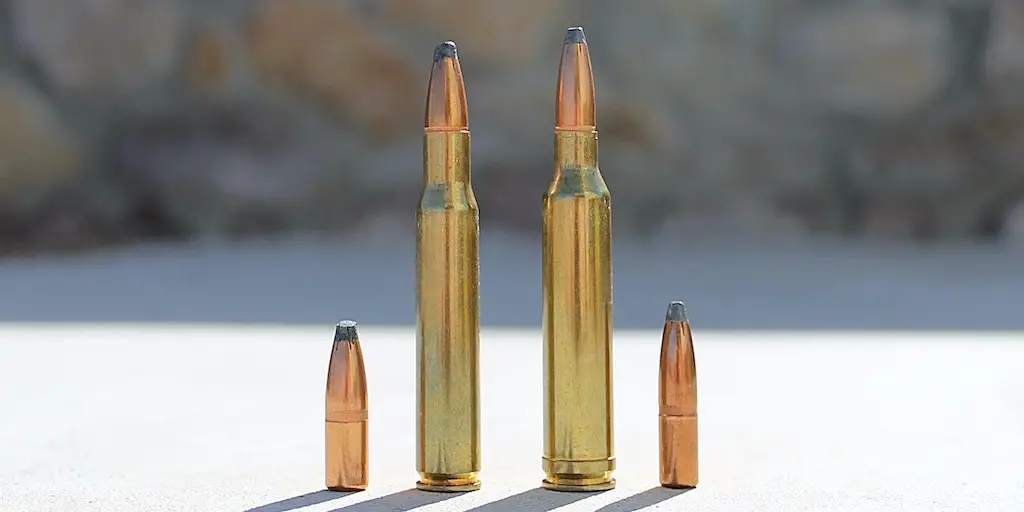
Bullet size is another one of the other obvious differences between the 7mm Rem Mag vs 30-06. Each cartridge uses different diameter bullets: .284″ for the Remington cartridge and .308″ for the Springfield.
Everything else being equal, the smaller diameter 7mm bullets have a higher ballistic coefficient and a higher sectional density than the larger diameter bullets of the same weight from the .30-06 Springfield. However, the .30-06 generally uses heavier bullets than the 7mm Remington Magnum.
The vast majority of 7mm Rem Mag factory loads shoot bullets in the 139-175 grain range. Of these, 140 grain, 150 grain, 160 grain, and 175 grain loads are by far the most common.
On the other hand, though it’s possible to find .30-06 ammo shooting bullets weighing as little as 110 grains and as heavy as 220 grains, most .30-06 Springfield factory loads use 150 grain, 165 grain, 180 grain, or 200 grain bullets.
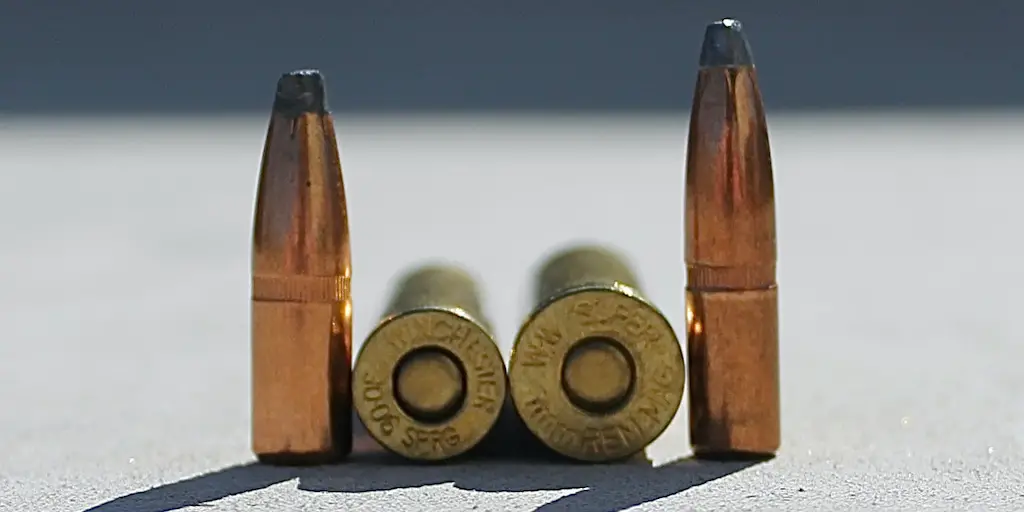
The 7mm Remington Magnum is also loaded to a higher pressure than the .30-06 (61,000psi vs 60,000psi).
Note: while the powder capacity figures listed below do give a good indication of the differences between the two cartridges, exact case capacities vary slightly according to the brand of brass used.
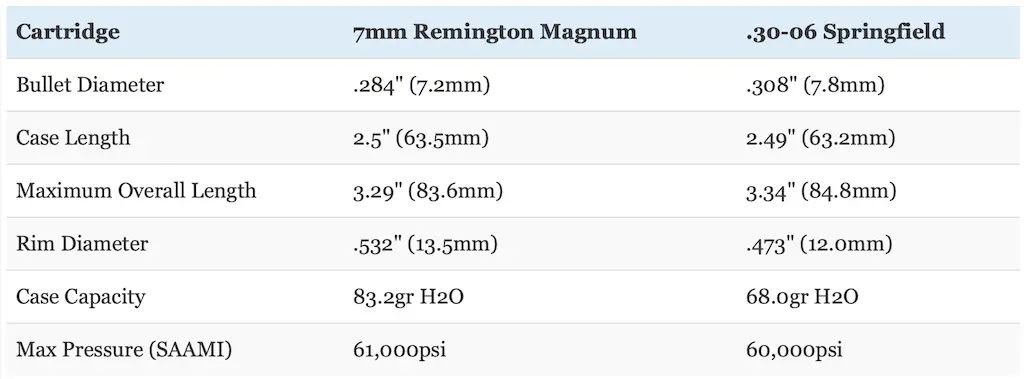
30-06 vs 7mm Rem Mag Ballistics
Not surprisingly, the differences in the external dimensions of the 7mm Remington Magnum and the .30-06 Springfield translate into some pretty significant differences in their ballistic performance. This is illustrated in the table below comparing Hornady Precision Hunter, Federal Premium Trophy Bonded Bear Claw, and Winchester Deer Season XP factory ammunition.
I chose those particular factory loads because they provide a good demonstration of the performance of each cartridge when using wide spectrum of different bullets. The Winchester loads use light for caliber bullets, the Federal loads use very heavy for caliber bullets, and the Hornady loads use heavy for caliber, exceptionally aerodynamic bullets for each cartridge.
Specifically, the 7mm Remington Magnum loads use a 140gr Extreme Point (.484 BC), a 162gr ELD-X (.631 BC), and a 175gr Trophy Bonded Bear Claw (.407 BC). The .30-06 loads use a 150gr Extreme Point (.392 BC), a 178gr ELD-X (.552 BC), and a 200gr Trophy Bonded Bear Claw (.395 BC).
Note that the bullets used by 7mm Remington Magnum in each load are more aerodynamic than those used by the .30-06 Springfield for the exact same load. More on this in a minute.
All six loads used a 200 yard zero.
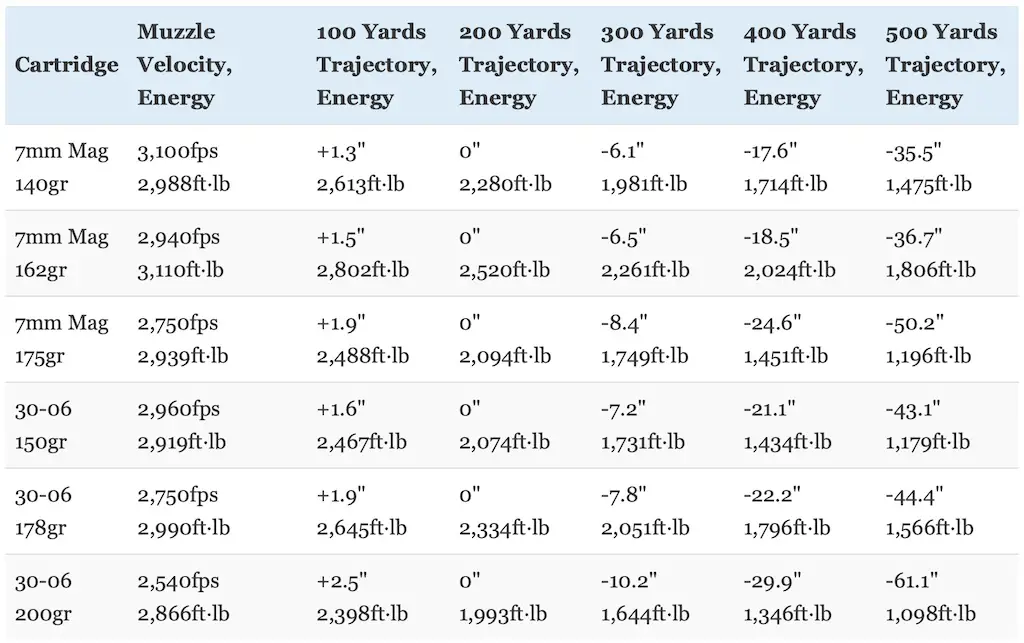
As you can see, the 7mm Remington Magnum has a flatter trajectory and more kinetic energy than comparable .30-06 Springfield loads at all ranges. Additionally, since it uses more aerodynamic bullets with a higher ballistic coefficient, that gap in performance grows in favor of the 7mm Mag as range increases.
Specifically, the 7mm Rem Mag has about 2-4% more muzzle energy than the .30-06 with these three particular loads. That turns into a 9-25% advantage in favor of 7mm Rem Mag at 500 yards.
At 500 yards, the various .30-06 loads have about 7-10″ (~20%) more bullet drop than comparable 7mm Rem Mag loads.
We’ll talk more about those numbers and what they mean in a minute.
The chart below compares how much a 10 mile per hour crosswind impacts those same 7mm Rem Mag and .30-06 loads out to 500 yards.
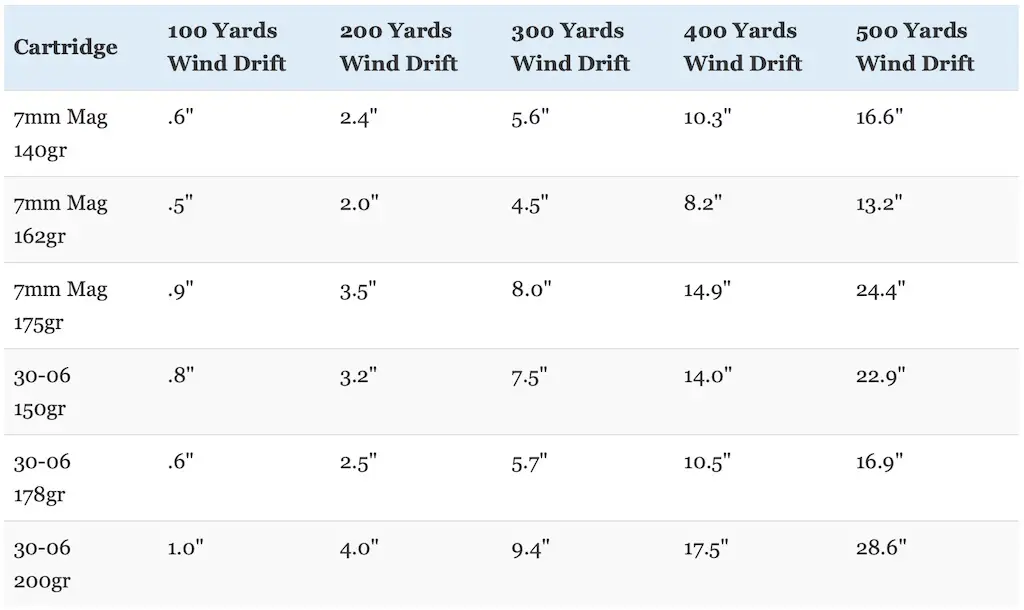
As you can see, the 7mm Remington Magnum also has a big advantage in this area as well. That makes sense since the cartridge is shooting more aerodynamic bullets at a higher velocity.
The exact details vary by load of course. Once again though, the gap in performance increases with range in favor of the 7mm Remington Magnum.
Update 25 July 2022:
What about the 175gr TBBC vs 178gr ELD-X?
I’ve received a number of questions and comments regarding the fact that the 178gr ELD-X load from the 30-06 has a flatter trajectory and more retained energy than the 175gr 7mm Trophy Bonded Bear Claw.
Those two bullets are closest in weight, so comparing those two loads is the best comparison of those cartridges, right?
Absolutely not.
Take a look at the photo below (178gr .30 cal ELD-X on the left and 175gr 7mm TBBC on the right) and the reasons why should be obvious.
For a detailed discussion on this exact subject (to include why it’s NOT appropriate to compare different bullets of the same or similar weight), check out this post on Patreon.
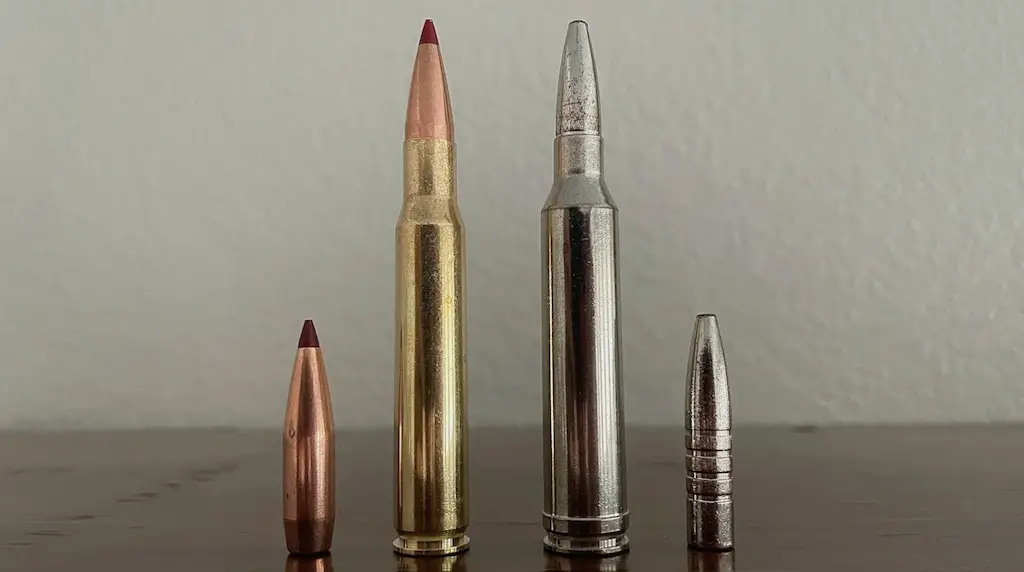
Moving on, let’s talk about recoil.
The table below compares the recoil produced by the handloads that approximate the performance of the Hornady Precision Hunter factory load above for each cartridge when fired from identical 8 pound rifles.
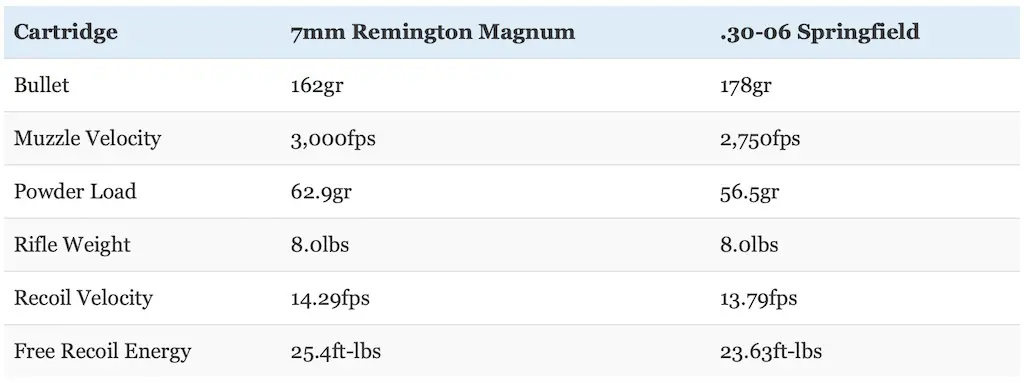
Felt recoil will vary from shooter to shooter and rifle to rifle, but free recoil energy is still a useful way to compare cartridges.
As you can see, the 7mm Remington Magnum has slightly more recoil than the .30-06. In this case, the 7mm Rem Mag produces 7.5% more free recoil energy than the .30-06.
That should not be surprising at all. After all, the 7mm Rem Mag is a heavy hitting belted magnum that burns a lot more powder and produces higher velocities.
Basically, the 7mm Rem Mag should be expected to hit a little harder on both ends, which is exactly the case.
This can be mitigated to a certain extent with the use of a suppressor, muzzle brake, or a good recoil pad. So the extra recoil of the 7mm Rem Mag isn’t necessarily a deal breaker for many people, especially since it only recoils a little more than the .30-06. All things considered, the 7mm Remington Magnum is one of the more lighter recoiling magnums (particularly when compared to the .300 Win Mag or .338 Win Mag).
Recoil is certainly worth considering though. If we’re being honest, neither cartridge is really suitable for hunters or shooters who are very sensitive to recoil.
Don’t underestimate the impact that recoil has on the ability of a person to shoot accurately either. Some people do handle recoil better than others, but all other things being equal, they will absolutely shoot more accurately with a milder recoiling cartridge.
Additionally, there are a couple of other factors that are also worth discussing though.
First, the .30-06 uses larger diameter bullets than the 7mm Rem Mag.
Specifically, the larger diameter .308″ bullets used by the .30-06 have about 18% more frontal surface area (also known as cross sectional area) than the .284″ bullets used by the 7mm Rem Mag (.0745 vs .0633 square inches). All other things being equal, a bigger bullet will make a bigger hole, cause more tissue damage, and result in more blood loss.
This is a definite, though slight, factor in favor of the .30-06.

On the other hand, as we covered earlier, those longer, heavy for caliber .284″ bullets have a higher ballistic coefficient than the most common bullets used in the .30-06 though.
The .284″/7mm bore diameter is in something of a sweet spot where it’s easier to manufacture very high BC bullets that’s aren’t especially heavy. Those aerodynamic projectiles don’t slow down as fast and are more resistant to wind drift.
The most popular 7mm bullets also have a relatively high sectional density (SD).
Sectional density (SD) is a measure of the ratio of the diameter of a projectile to its mass. All other things equal, a heavier projectile of a given caliber will be longer and therefore have a higher sectional density and consequently penetrate deeper than projectiles with a lower mass and sectional density.
Everything else being equal, the smaller diameter 7mm bullets have a higher ballistic coefficient and a higher sectional density than the larger diameter bullets of the same weight from the .30-06 Springfield. However, the .30-06 generally uses heavier bullets than the 7mm Remington Magnum.
All that being said, the 7mm Rem Mag still has a slight edge with most bullets in common use, even when compared to heavier .30 caliber bullets.
As an example, 140 grain, 150 grain, and 175 grain .284″ bullets have sectional densities of .248, .266, and .310 respectively. This compares favorably to 150 grain, 180 grain, and 200 grain .308″ bullets which have sectional densities of .226, .271, and .301 respectively.
This also applies to ballistic coefficient.
The bullets used in this comparison illustrate those differences well with the 7mm Remington Magnum using 140gr (.484 BC), 162gr (.631 BC), and 175gr (.407 BC) bullets compared to the 150gr (.392 BC), 178gr (.552 BC), and 200gr (.395 BC) bullets used by the .30-06.
What about 7mm Rem Mag vs .30-06 Springfield accuracy?
Gun writers have spilled a lot of ink comparing the accuracy of the 7mm Rem Mag vs 30-06 over the years. While picking the most accurate cartridge of the two is a relatively contentious subject, most people agree that both the 7mm Mag and .30-06 are capable of excellent accuracy.
Not surprisingly, both cartridges have seen extensive use in long range shooting competitions and both have served with distinction with military and police snipers as well as with for precision shooters.
So where do we stand with each cartridge?
7mm Rem Mag vs 30-06
The 7mm Rem Mag fires smaller caliber and lighter, but generally more aerodynamic bullets at a higher velocity than the .30-06 Springfield. The 7mm Rem Mag has a flatter trajectory, more kinetic energy at typical hunting ranges, and is also better for longer range shots, but the .30-06 has less recoil.
With a flatter trajectory, less wind drift, and more retained energy at extended range, the 7mm Rem Mag does have a definite, though not gigantic, advantage over the .30-06 Springfield in external ballistics at typical hunting ranges. This makes the cartridge a little more forgiving of range or wind estimation errors than the .30-06 Springfield.
While that’s certainly something to keep in mind, laser rangefinders and modern scopes with easily adjustable ballistic turrets (like the Leupold VX-5) make adjusting for bullet drop much simpler now than it was a few decades ago.
The most popular bullet weights for the 7mm Rem Mag also tend to be more aerodynamic than the most popular bullet weights used by the .30-06. So, the advantages the 7mm Remington Magnum cartridge has with energy, trajectory, and wind drift grow slightly at extended range.
Those 7mm bullets also tend to have a higher sectional density as well, which assists with penetration to help the cartridge “punch above its weight” in a manner similar to the 7x57mm or 9.3x62mm Mauser cartridges.
As good as the .30-06 is (and I do think it’s an excellent cartridge), the 7mm Remington Magnum just simply hits with a little more authority, especially at longer range.
On the other hand, the .30-06 has an advantage when it comes to frontal surface area (which gives a tiny bit more room for error with shot placement), uses heavier bullets, and has a little less recoil.
It might seem like I’m splitting hairs here when talking about the strengths and weaknesses of the two cartridges. That’s absolutely true to a certain degree.
While they certainly have different advantages, both cartridges are very accurate, relatively flat shooting, and hit hard enough for use on a variety of game out to several hundred yards. The 7mm Rem Mag may be a better choice for use on bigger game and/or on game at longer range, but the .30-06 is still a darn good cartridge.
However, regardless of whether you’re using a 7mm Remington Magnum or a .30-06 Springfield, no deer, elk, black bear, moose or pronghorn will go far if you put a well constructed bullet into the vitals during a real world hunting scenario.
30-06 vs 7mm Rem Mag Barrel Life
Since the two cartridges have a different bore diameter and vastly different case capacities, there can be some significant difference in barrel life with the three cartridges.
Simply put, burning more powder in a similar sized space will result in shorter barrel life.
At the same time, burning more powder is a smaller sized space will result in even shorter barrel life.
Well, the 7mm Remington Magnum has a smaller bore size and uses a much bigger powder charge.
This means that, in general, the 7mm Rem Mag will simply wear out barrels faster than the .30-06 Springfield. Exactly how fast that occurs depends on a number of factors like the quality of the barrel, the exact ammunition used, etc.
For serious target shooters, this can be a concern. However, the good news for hunters is that typical barrel life for all of these cartridges is more than enough to last for many, many years of hunting with no issues at all.
So, there isn’t a tremendous practical difference in 7mm Rem Mag vs 30-06 barrel life as far as most hunters are concerned.
7mm Rem Mag vs 30-06 Ammo
The .30-06 Springfield and the 7mm Remington Magnum are both extremely popular centerfire rifle cartridges. That said, the .30-06 is definitely the most widely used of the two in general, though the 7mm Remington Magnum is by no means rare.
So, they’re both in common use and ammo is usually easy to find for both. Availability also likely varies regionally though. For instance, more people tend to use the 7mm Remington Magnum in many western states where they’re more likely to need the advantages the cartridge provides at longer range.
In general, .30-06 ammo is typically noticeably cheaper than 7mm Rem Mag ammo.
The big ammunition manufacturers like Barnes, Berger, Browning, Federal Premium, Hornady, HSM, Nosler, Remington, Sierra, Sig Sauer, Swift, and Winchester produce an incredible variety of ammo for the .30-06 Springfield and 7mm Remington Magnum.
In each case, there is normally a good selection of bullet types and weights for each cartridge suitable for big game hunting ranging from stuff like Remington Core Lokt and Winchester Super X ammo to Federal Premium Gold Medal and Hornady Precision Hunter factory loads.
During normal times, it’s usually very easy to find ammo for both cartridges and almost any gun or sporting goods store will have a wide variety of .30-06 and 7mm Rem Mag ammo in stock.
Ammo availability is also usually excellent online and the bigger retailers typically have a good selection of quality factory ammo for both cartridges as well.
BUY SOME GREAT 7mm REM MAG AMMO HERE
BUY SOME EXCELLENT 30-06 SPRINGFIELD AMMO HERE
If you’d like to learn more about some of the various hunting ammunition choices for the 7mm Remington Magnum and 30-06 cartridges, read these articles:
Best 7mm Rem Mag Ammo For Hunting Elk, Deer, And Other Big Game
Best 30-06 Ammo For Hunting Elk, Deer, Bear, Hogs, & Other Game
Handloaders will appreciate the fact that reloading components for both cartridges are also readily available and there’s an especially wide variety of bullet choices for each cartridge. So, you should not have any trouble working up a good custom load for either one if you like to handload.
The 7mm Remington Magnum uses the same .284″ bullet size as the 7mm-08 Remington, .280 Remington, .280 Ackley Improved, 7mm WSM, 7mm STW, 7mm Weatherby Magnum, and 7mm Remington Ultra Magnum.
The .30-06 Springfield uses the same .308″ bullet size as the .308 Winchester, .30-30 Winchester, .300 Win Mag, 300 WSM, .300 Ultra Mag, and .300 PRC.
Bullets like the Barnes LRX, TSX, TTSX, and TAC-X, the Berger VLD and Hybrid Hunter, the Hornady A-Max, ELD-X, GMX, InterBond, InterLock, SST, and V-Max, the Nosler AccuBond, Ballistic Tip, E-Tip, and Partition, the Sierra GameChanger and GameKing, the Swift Scirocco and A-Frame, (just to name a few) are options for if you want to reload the 7mm Remington Magnum and the .30-06 Springfield.

7mm Rem Mag vs 30-06 Rifles
In addition to the great selection of ammunition available in 7mm Remington Magnum and .30-06, there are also many quality rifles manufactured in these cartridges.
Both cartridges are extremely common in bolt-action rifles. In fact, just about every really popular bolt-action hunting rifle in current production is available in both cartridges.
For instance, both the 7mm Remington Magnum and .30-06 Springfield are available in several different versions of the Remington Model 700 and Winchester Model 70. The same goes for the Browning X-Bolt, Browning AB3, Christensen Arms Ridgeline, Kimber Hunter, Mossberg Patriot, Ruger Hawkeye, Savage Axis, Savage 110, Tikka T3 and Tikka T3x, Weatherby Vanguard, and Winchester XPR.
That said, the .30-06 is the more popular of the two. So, there’s generally a better selection of rifles in that chambering. It’s also easier to find .30-06 rifles that are less expensive.
On the other hand, while it’s also available in a wide range of rifle models, the 7mm Rem Mag is more common with higher end rifles designed for better performance at longer ranges. That’s not a hard and fast rule though.
It’s also important to realize that gun manufacturers tend to put longer barrels on rifles chambered in 7mm Remington Magnum (and other magnum cartridges in general). This is because those cartridges need a longer barrel to effectively and efficiently burn that larger powder charge.
All things considered, rifles chambered in 7mm Rem Mag tend to be slightly longer, heavier, and more unwieldy than rifles chambered in .30-06.
The Ruger Hawkeye Hunter illustrates these differences well.
When chambered in .30-06 Springfield, the rifle has a 22″ barrel, an overall length of 42.75″, and weighs 7.4 pounds. The same rifle chambered in 7mm Remington Magnum has a 24″ barrel, is 44.75″ long, and weighs 8.1 pounds.
The rifle chambered in 7mm Remington Magnum is 2″ longer and weighs nearly a pound more than the exact same model chambered in .30-06.
Barrel lengths do vary depending on the manufacturer and exact model. However, 22″ barrels are very common with the .30-06 while 24″ and even 26″ barrels are pretty standard with the 7mm Remington Magnum.
Having a shorter and lighter rifle is more important on some hunts than on others. So, just keep that in mind.
BUY A GREAT 7mm REM MAG RIFLE HERE
BUY A NICE 30-06 SPRINGFIELD RIFLE HERE
7mm Rem Mag vs 30-06: Which Is Right For You?
Do you primarily hunt medium sized game like whitetail deer, feral hogs, or black bear at ranges within 200 yards? Both are extremely effective deer hunting cartridges and will absolutely get the job done on medium sized game if you do your part. The .30-06 in particular is a great deer hunting cartridge and remains one of the most popular North American hunting cartridges. There’s nothing wrong with using the 7mm Rem Mag on deer inside of 200 yards, but it’s really more gun than you need for that sort of work though (and it’s also a little rougher on both the shoulder and wallet).
If you’re going to be hunting in thick brush or in the tight confines of a deer stand, remember what I just mentioned about the size difference with 30-06 vs 7mm Rem Mag rifles. That extra couple of inches in overall length of a rifle can be a real headache to deal with when trying to quickly and quietly maneuver for a shot.
Are you looking for the cartridge better suited for long range hunting for game like mule deer or pronghorn in open country where you might need to take a shot at several hundred yards? Once again, they’ll both work really well in this role. The .30-06 Springfield is a very good choice for this sort of hunting, but this is where the 7mm Rem Mag really starts to shine because it carries more energy out past 200 yards. The advantages the cartridge has in terms of bullet drop and wind drift start to become much more important at longer range as well. Not surprisingly, the 7mm Rem Mag is very popular with antelope hunters in places like Wyoming where windy conditions are common.
Do you want a hunting cartridge that’s well suited for caribou, moose, elk, eland, kudu, or red stag hunting? The .30-06 Springfield is a fantastic choice for use on bigger game and there’s not a darn thing wrong with using it on one of those hunts. Personally, I lean towards the .30-06 because it uses larger diameter and heavier bullets, but there’s also a good argument to be made for the 7mm Rem Mag as well, especially on hunts were a longer range shot might be necessary. With this in mind, some people prefer the 7mm Rem Mag because it carries more kinetic energy downrange (especially at longer range) and because it uses high SD bullets that tend to penetrate a little better.
Regardless of which cartridge you choose, use a controlled expansion projectile and a heavier bullet weight for your elk or moose hunt.
Are you specifically hunting brown or grizzly bear? What if you hunt in Canada or Alaska and need a heavy hitting cartridge just in case you find yourself on the wrong end of a grizzly/brown bear attack? Neither would be my first choice for use on those hunts. That said, they will definitely work in a pinch. Of the two, I’d go with the .30-06 since it uses larger diameter and heavier bullets. Make sure you use premium, heavy for caliber 200gr or 220gr bullets if you go that route (the 200gr Trophy Bonded Bear Claw I mentioned earlier is a darn good choice).
For what it’s worth, Roy Lindsley used a .30-06 Springfield to take the current Boone & Crockett record Alaska brown bear back in 1952. But then again, that hunt took place before cartridges like the 7mm Remington Magnum, .300 Winchester Magnum, and .338 Winchester Magnum even existed.
Are you sensitive to recoil and in need of a serious low recoil cartridge? Neither is known as being a light recoiling cartridge. That said, the .30-06 does tend to have a little bit less free recoil energy than the 7mm Rem Mag.
Do you want the round that is best suited for target shooting out past 400 yards or so in a precision rifle? Both will work and have excellent reputations for precision shooting, but I lean towards the 7mm Remington Magnum here because of the advantages the cartridge has for longer range shooting.
The 7mm Remington Magnum and .30-06 Springfield are both excellent rifle cartridges. While the 7mm Remington Magnum does offer certain advantages over the .30-06 in some aspects, the old “aught six” is still getting it done well over a century after coming on the scene! All things considered, the difference between them (7mm Rem Mag vs 30-06) isn’t as great as it is sometimes made out to be and the animal will never know the difference if your shot is placed in the right spot.
So, carefully analyze your potential needs before making a decision. If you really need the advantages the 7mm Remington Magnum offers, then by all means purchase one. However, the .30-06 will work really well for most hunters. In the end, a lot of this decision comes down to personal preference. So, choose the one that you feel most comfortable with and it will probably serve you well afield. Good luck!
NEXT: 308 vs 30-06 SPRINGFIELD vs 300 WIN MAG: WHICH SHOULD YOU HUNT WITH?
Enjoy this article comparing the .30-06 Springfield and 7mm Remington Magnum cartridges? Please share it with your friends on Facebook and Twitter.
The Lyman 50th Edition (p214-216 and p246-250) and Hornady 10th Edition (p406-411 and p510-522) reloading manuals were used as references for the history of the cartridges. I obtained the data used to compare the trajectory of the cartridges from Hornady (here and here), Federal Premium (here and here), and Winchester (here and here). Data used to calculate recoil was obtained from the Hornady reloading manual. Case capacities were obtained from Chuck Hawks (here). Maximum pressure obtained from SAAMI (p23 & 29). I used ShootersCalculator.com to compare trajectory and recoil for the cartridges.
Make sure you subscribe to The Big Game Hunting Podcast and follow The Big Game Hunting Blog on Facebook, Instagram, Twitter, and YouTube.
John McAdams is a proficient blogger, experienced shooter, and long time hunter who has pursued big game in 8 different countries on 3 separate continents. John graduated from the United States Military Academy at West Point and is a veteran of combat tours with the US Army in Iraq & Afghanistan. In addition to founding and writing for The Big Game Hunting Blog, John has written for outdoor publications like Bear Hunting Magazine, The Texas State Rifle Association newsletter, Texas Wildlife Magazine, & Wide Open Spaces. Learn more about John here, read some of John’s most popular articles, and be sure to subscribe to his show: the Big Game Hunting Podcast.

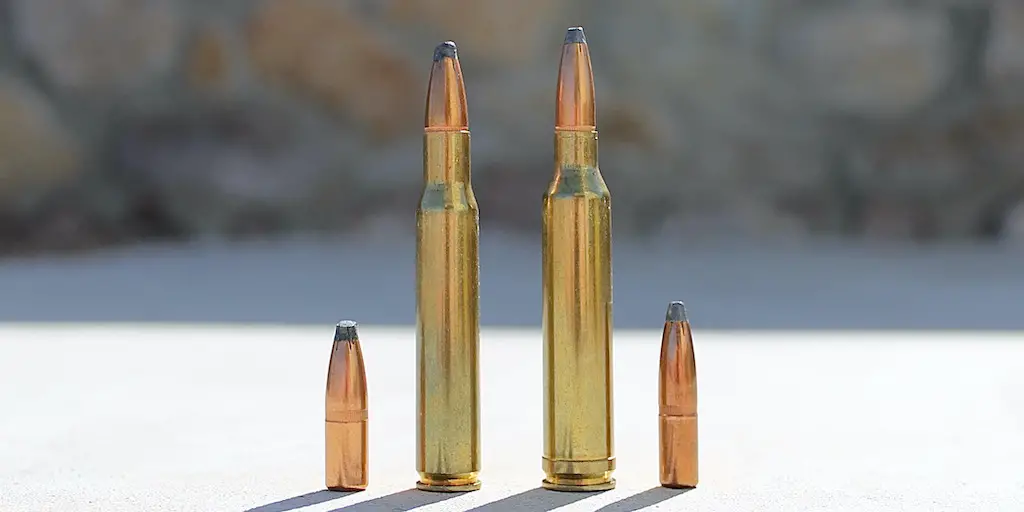


If you compare the 175g to the 178g, which are the closest , then your be loved 7mm falls short. Why would you compare a 175g to a 200g? Get out of here with that crap. Liberal rag
Go back and read the article again, paying particular attention to the “What about the 175gr TBBC vs 178gr ELD-X?” section to learn why that’s not a good comparison.
Check out this post on Patreon for a more detailed description on the pitfalls of making a straight comparison between the 7mm 175gr Trophy Bonded Bear Claw and the 30 caliber 178gr ELD-X.
I think your ballistics are a bit misleading. If you compare similar bullet weights the 30-06 has similar muzzle velocity, and the trajectory is flatter and the energy is higher
Go back and read the article again, paying particular attention to the “What about the 175gr TBBC vs 178gr ELD-X?” section to learn why that’s not a good comparison.
Check out this post on Patreon for a more detailed description on the pitfalls of making a straight comparison between the 7mm 175gr Trophy Bonded Bear Claw and the 30 caliber 178gr ELD-X.
You state the 7mm has the advantage but when you compare the 30-06 178gr to the 7mm 175gr (the most comparable samples since they are of the closest weight) , even though the ’06 is very slightly heavier, it has a flatter trajectory, less wind drift and maintains more energy. Am I missing something?
Go back and read the article again, paying particular attention to the “What about the 175gr TBBC vs 178gr ELD-X?” section to learn why that’s not a good comparison.
Check out this post on Patreon for a more detailed description on the pitfalls of making a straight comparison between the 7mm 175gr Trophy Bonded Bear Claw and the 30 caliber 178gr ELD-X.
As Someone who is looking to purchase their first rifle,
with the intention of hunting deer and eventually working up to elk and bigger game in the
Pacific Northwest. What would you personally prefer? Open to all anecdotal inputs.
A buddy and I who hunt together a lot, both have a Tikka T3, his is in 30-06, mine 7mm Rem Mag. We both live in Oregon and we hunt both sides of the Cascade Range. We both agree on this: when hunting on the West side of the Cascades, I would rather have his 30-06 and when we are on the East side of the Cascades, he would rather have my 7mm Rem Mag. While hiking through the forest on the West side we encounter a fair amount of underbrush and the longer and heaver 7mm Rem Mag Tikka T3 needs to be threaded through the underbrush. It is amazing how 2 inches of barrel length can have an impact (almost wish I had a carbine at times). Conversely, when we are on the East side, he would prefer to use my Tikka T3 because of the much more open country and distance shots.
When I was choosing between both calibers I went with the 7mm Rem Mag for its flatter trajectory over the 30-06. However, both my buddy and I live on the West side and sometimes I wonder if I had made the best choice. According to my buddy, he still wishes he had bought the 7mm Rem Mag instead of the 30-06. I kindly remind him, that his ammo is cheaper and easier to obtain than mine. However, I now reload the 7mm Rem Mag and most likely I will be reloading the 30-06 for him. I already know he will need a lot less powder than I do.
Both my buddy and I had acquired our Tikka’s shortly before we meet. We now have experienced what it was like to walk a mile with the other man’s rifle and that taught us a lot about both.
In short, it would be nice to own the same gun in both calibers, but reality says differently.
I don’t know if this has helped you or confused the matter worse.
One footnote: When I’m in the woods I carry a 44 Mag revolver. I may never need it, yet, just in case.
Your 7 mag vs ’06 comparison is flawed. If you don’t compare the same grain bullet your results are misleading at best. I have both calibers and they are neck and neck for the most part.
Go back and read the article again, paying particular attention to the “What about the 175gr TBBC vs 178gr ELD-X?” section to learn why that’s not a good comparison.
Check out this post on Patreon for a more detailed description on the pitfalls of making a straight comparison between the 7mm 175gr Trophy Bonded Bear Claw and the 30 caliber 178gr ELD-X.